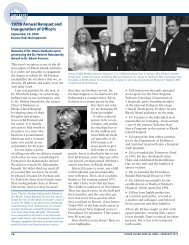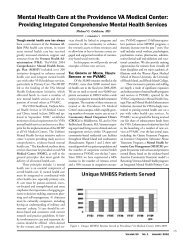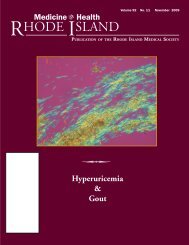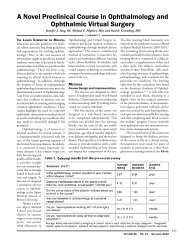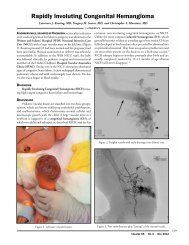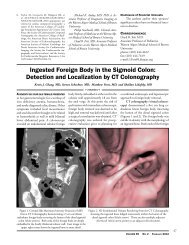The Providence VA Medical Center - Rhode Island Medical Society
The Providence VA Medical Center - Rhode Island Medical Society
The Providence VA Medical Center - Rhode Island Medical Society
- No tags were found...
Create successful ePaper yourself
Turn your PDF publications into a flip-book with our unique Google optimized e-Paper software.
<strong>The</strong> Creative ClinicanFooled By the Fragments:Masquerading MicroangiopathySamir Dalia, MD, Cannon Milani, MD, Jorge Castillo, MD, Anthony Mega, MD, Fred J. Schiffman, MDA 65-year-old woman presented to a hospital withconfusion, shortness of breath, and ecchymoticskin lesions. She was afebrile. Her hemoglobinwas 3·6 g/dL (normal [nl] 11-15 g/dL),platelet count was 62 x 10 3 /mm 3 (nl 150-450x 10 3 /mm 3 ), white blood cell count was 5·9 x10 3 /mm 3 (nl 3.5-11 x 10 3 /mm 3 ), mean corpuscularvolume (MCV) was 114 fL (nl 80-99 fL),creatinine was 1·9 mg/dL (nl 0·4-1·3 mg/dL),and serum lactate dehydrogenase (LDH) was2,200 IU/L (nl 50-175 IU/L). Based on herconfusion, anemia, thrombocytopenia, and elevatedserum creatinine and LDH, a diagnosisof thrombotic thrombocytopenic purpura(TTP) was made.<strong>The</strong> patient received four units of packedred blood cells and was transferred to our hospitalfor urgent plasma exchange (PEX). Uponarrival, her history was unremarkable whilephysical examination was notable for tangentialspeech, conjunctival pallor, slight macroglossia,and ecchymotic areas on her extremities.Cardiopulmonary exam was normal andthere was no lymphadenopathy or hepatosplenomegaly.<strong>The</strong> patient’s peripheral blood smearshowed 1% to 5% schistocytes per high-powerfield that further suggested a microangiopathicprocess. However, macroovalocytes,hypersegmented neutrophils, polychromasia,and occasional teardrop cells were observed.(Figure 1). <strong>The</strong> patient received 2 units offresh frozen plasma (FFP) to correct hercoagulopathy and to partially replenish herpresumptively low ADAMTS13 while a serumcobalamin level and anti-IF antibody werechecked. <strong>The</strong> patient was empirically given adose of intramuscular cyanocobalamin.<strong>The</strong> patient’s serum cobalamin level returnedat 51 pg/ml (nl 211-911 pg/ml) andher anti-IF antibody was positive. After fourteendays of intramuscular cobalamin her peripheralblood smear showed resolution ofmegaloblastic changes and her mental statusand ecchymotic areas improved.<strong>The</strong> hematologic aberrations seen in cobalamin deficiency can includepancytopenia, the presence of hypersegmented neutrophils andmacroovalocytes on peripheral blood smear, and elevated serum levels ofLDH and bilirubin. 1 As seen in the present case, severe cobalamin deficiencycan also present with a clinical and hematological picture similarto a microangiopathic hemolytic process. In addition, neuropsychiatricmanifestations of cobalamin deficiency are marked by paresthesias, ataxia,urinary and fecal incontinence, impotence, optic atrophy, memory loss,dementia, and various psychiatric disorders including depression, hallucinations,and personality changes. 1Schistocyte formation in cobalamin deficiency may result from increasedmembrane rigidity with reduced deformability and subsequentlysis as RBCs pass through the reticuloendothelial system 2 . <strong>The</strong> anemiaof cobalamin deficiency is thought to result from a combination of lackof production and increased destruction of RBCs while thrombocytopeniais caused by a lack of production of platelets.We believe that in cases of apparent TTP with high MCV or otherdata suggestive of cobalamin deficiency, serum cobalamin levels shouldalways be checked. If a suspicion for cobalamin deficiency arises in theevaluation of TTP, empiric treatment with infusion of FFP can be useduntil more definitive testing is performed. PEX may be associated withserious side effects. In a nine-year cohort study of 206 consecutive patientstreated for TTP, 5 of the 206 (2%) died of complications of PEXtreatment. Fifty-three patients (26%) had major complications attributedto PEX treatment, including systemic infection, venous thrombosis, andhypotension requiring blood pressure support 3 . With review of a pe-Figure 1. Peripheral blood smear of our patient with hallmarks of cobalamindeficiency. <strong>The</strong>re is marked anisopoikilocytosis. Ovalocyte (1), macroovalocyte(2,3), hypersegmented neutrophil with 5 lobes (4), schistocyte (5) andteardrop cell (6).VOLUME 93 NO. 1 JANUARY 201025




